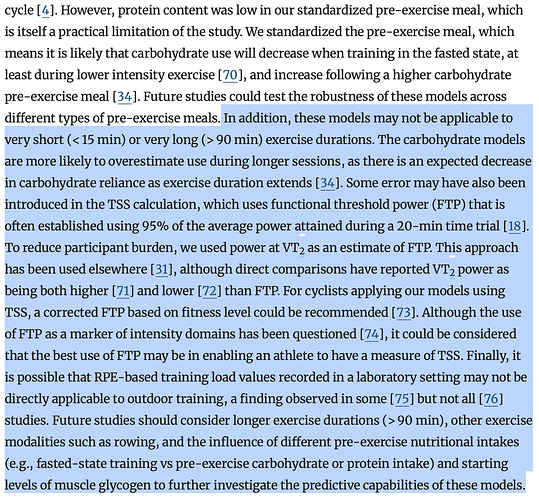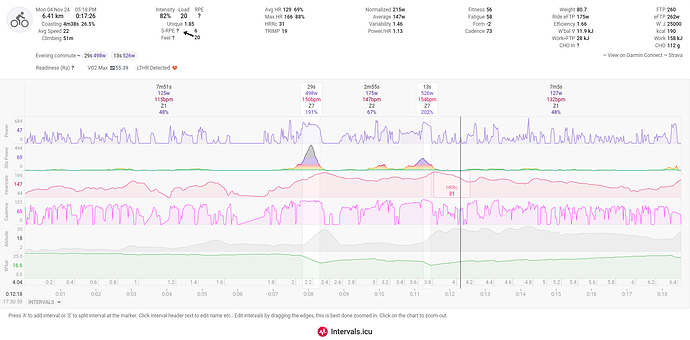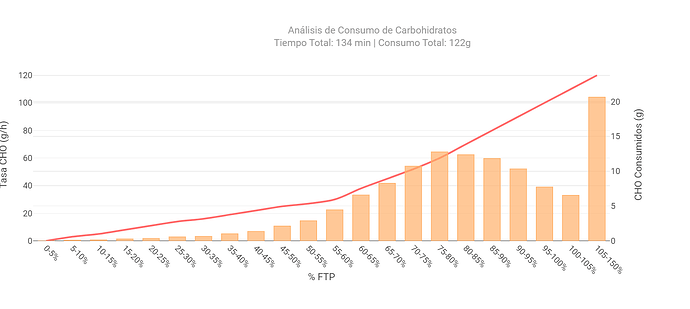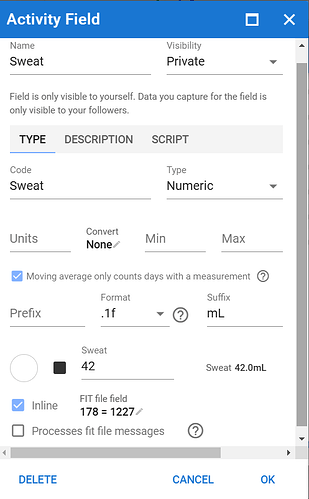Thanks, I discovered it when selecting the developer mode.
Hmm. I don’t know enough about this topic. I played around with the data for a 150km 5h ride I did recently just to see what things the formula is sensitive about. I have unit tests derived from the worked examples in the video so I think I have the calculation right.
- Ride stats: (work 3325 kJ) TSS=242, FTP=280, duration 317 mins, prior day TSS=99, continuous=true = 817g carbs.
- Change FTP to 300: 824g
- Change FTP to 250: 806g
- Change TSS to 200: 699g
- Change TSS to 300: 1017g
- Change continuous to false: 852g
- Change duration to 240 minutes: 716g
So not surprisingly the biggie is TSS as it is squared in the formula. So if TSS is inflated so will the g of carbs.
But I really don’t know if 817g of carbs “makes sense” for that ride.
Hi David – as a rough rule of thumb, the kJ of work done on a ride is equal to the calorie requirement in kcal. One gram of CHO supplies about 4 kcal of energy.
It’s much more difficult to come up with a rule for how much of your energy is obtained from burning fat and how much from CHO, and it will vary from person to person. Somewhere around mid Z2 you’re likely to be getting half your energy from CHO, and this proportion increases as intensity goes up. Above threhhold you’ll be burning very little fat. The relationship between %fat and intensity is not linear.
For me, riding at an average of 133W, I’m doing about 500 kJ/hr of work and so need 500 kcal/hr of fuel. 133W is somewhere around the middle of my Z2, so I reckon to need about 250 kcal/hr or 60g of CHO per hour. This calculation doesn’t take into account periods of higher intensity, but it’s enabled me to avoid bonking so far.
I must read the paper you’ve reference for any new insights.
PS – for your ride, the calculation of 817g for a 3325 kJ ride means you got nearly all your energy from CHO, which is unlikely for such a long ride. I think the model reflects a relatively narrow range of activities where the relationship between TSS and CHO use is approximately linear. As duration rises and intensity falls, I guess it would increasingly overestimate the CHO used.
Sorry if you’ve got enough datapoints by now, but I think mine’s even more extreme than some others above I think? (With 1g CHO being 4kcal it’s 2.35× kcal number, however reliable that one may be)
As you can see I had a little too much fun during the small climbs, has this confused the algorithm?
(Cool feature though and definitely a thing I need to start paying more attention to, thank you!)
I have been reviewing several athletes, including my own activities and my opinion is that you are overestimating your carbohydrate intake, in 2h26m with an intensity of 0.73 you should have eaten 352 grams according to the paper, which is approximately 142 grams per hour. The algorithm I did gives me an estimate of 122 grams, which may not be correct either, but it is more logical.

I’ve been thinking about this. It’s an attractive idea to have a simple formula that you can just plug TSS into and get an estimate for CHO used, but as we’ve seen it works over a relatively narrow range and to get a decent estimate for longer rides would require another model, or more.
Another possible issue is that the variables in the model aren’t independent. TSS is dependent on duration and FTP, which appear elsewhere in the formula. I’ve no idea if this matters or not, but it makes me feel uncomfortable mathematically.
As we have computers to do the donkey work, maybe a brute force approach would work over the full range of rides. If you have a file of power output over the ride, and a table or formula relating %CHO usage to intensity (available from the literature, I’m sure), then it’s a trivial matter to calculate CHO usage on a minute by minute basis and add it up.
This loses the elegance and simplicity of the model, and would suffer inaccuracies from individual variation (a bit like 220 - age for max HR), but maybe it would do a better job for an app like intervals.icu?
That’s a very clever remark!
Why use both TSS AND duration if TSS already accounts for duration???
The TSS in the formula is actually TSS squared. So it allows curvilinear relationships. But as noted elsewhere, carb dependence really changes past 90 min so these formulas will need to be adjusted on longer rides
Again, I reiterate that the power of this community will make the product (Intervals.icu) better. We’ve got programmers, researchers, coaches all out in the field doing the work. We can work together to further improve and refine the data set to help everyone!
So many great insights into this topic.
I have been using a spreadsheet from Knowledge of Watts and Jeff Rothschild, There are Inscyd, Aerotune, and Xert platforms to converge values and data sets on. I think the basic point is that this nutrition fuelling game is way too beneficial for us NOT to try and get it right along the way.
I enjoy the conversations and discussions.
For the TSS and Intensity comments:
Using work (kJ) allows measuring volume and intensity at the same time. If you know your burn rate per hour or half-hour, you can work out what you need to consume by using about 40-50% of that value. Let’s say you’re riding at 150W (average power for 6 hours) that equates to:
- 150W average = 540kJ per hour (watts * total seconds / 1000), or 3240kJ total duration.
- 3240 * 40% = 1296 / 6 (hours) = 216kJ/hour
- 3240 * 50% = 1620 / 6 (hours) = 270kJ/hour
The 216-270kJ per hour is what you would need, which equates to 54-60g of carbs; divide the answer by 4.
Edit: Garmin allows this to be displayed as a metric, so it’s easy enough to track.There are charts showing kJ per hour or like me, every half hour. Not sure about other head units.
Yeah, there is a squared term in the equation to capture some non-linearity, but what’s missing (and can be implemented) is an adjustment down to account for decreasing carb dependence as the duration gets longer.
We can make it simple if targeting 50% of work
carbs per hour = average watts x .45
or even simpler, round up to .5
carbs per hour = average watts x 0.5
For example
carbs per hour = 150W x 0.5 = up to 75g hour
What happens on long rides?
From Tim Podlogar’s recent research, no matter how many carbs you drink/eat, your body will burn thru muscle glycogen.
Let say you are riding tempo, and slamming 120g/hour of carbs. No matter, your muscle glycogen will deplete in roughly 2-3 hours.
Morale of the story - after a few hours your body is running on what you eat/drink. Depending on your ftp and work rate, plan accordingly or bonk.
Eat/drink
- maltodextrose is used by the muscles immediately, up to 60g/hour (roughly)
- fructose takes 1-2 hours to be processed by the liver, up to 60g/hour (roughly)
Plan accordingly.
My humble opinion:
Carbohydrate consumption is too individual to be represented by an algorithm for EVERYONE. Here you should either work with individual tables or leave it alone.
I just want Intervals to show the nutrition/hydration recorded on my Garmin.
Hello,
I have added the “sweat” from my Garmin activities in intervals.icu activities by adding this (via “Custom Charts” on an activity):
The code 178 in the Fit File match this from Garmin activity.
It seems:
. Fluids in: code 179
. Calories in: code 177
Thank for this.
As Xavier just posted you can add custom fields for those easily. I am still figuring out how to make them “standard”.
I had a chat with Jeff this morning (tx @Jeff_Rothschild ) and I am going to try implementing the formula that works off activity kJ instead of TSS, at least for activities with power. It might do better for long duration activities. Jeff also has some “work in progress” for “long duration adjustment” that I will implement.
I’m using the custom field. I guess with different device manufacturers, the fields used in the fit file might not be the same.
This is exactly how progress is made! ![]() Thanks @Jeff_Rothschild and @David for your contributions to make us and our athletes better!
Thanks @Jeff_Rothschild and @David for your contributions to make us and our athletes better!
Cheers,
Jeff



